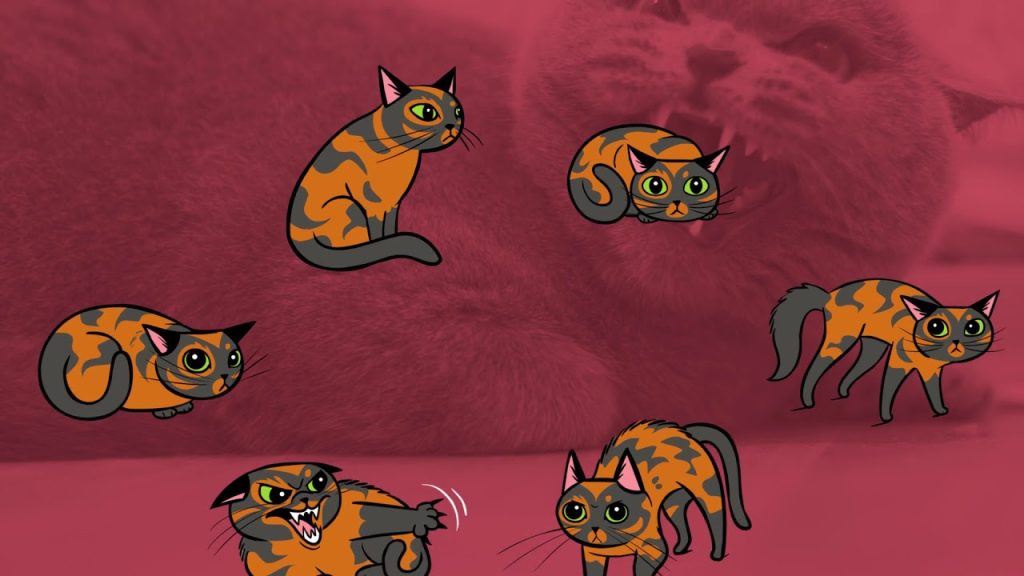Nonverbal Communication Between Cats and Their Owners: Understanding the Signals

Decoding the Silent Language of Cats
As every cat owner knows, communication often transcends words. Cats possess a unique toolkit of nonverbal signals that can relay a wide array of emotions and needs. By understanding these signals, you can strengthen your bond with your feline friend, creating a more harmonious living environment for both you and your pet.
Why Nonverbal Communication Matters
Nonverbal cues are essential in the world of cats, as they depend on body language, facial expressions, and vocalizations to express their feelings. Cats are inherently independent creatures, and their subtle signals can provide a wealth of information. Here are some key aspects to consider:
- Body Language: A cat’s posture can indicate a range of emotions. For example, if a cat is relaxed, it may lie down with its paws tucked under its body, signaling safety and comfort. Conversely, an arched back and raised fur can indicate fear or aggression, warning you to maintain distance.
- Facial Expressions: Much like humans, cats use facial expressions to convey their emotional state. The position of their ears—forward can signify curiosity, while flattened ears indicate fear or irritation—provides critical insights into their mood. Large, dilated pupils often suggest excitement or fear, while slow blinking can show trust.
- Tail Position: The way a cat holds its tail is another indicator of its feelings. A tail held high and quivering can signify happiness or excitement, while a low or puffed-up tail may indicate annoyance or aggression.
Understanding these cues not only helps in recognizing your cat’s mood but also enhances their overall well-being. For example, if you notice signs of anxiety, such as a fearful posture or avoidance behavior, you can take proactive steps to create a more comfortable environment, whether that means providing hiding spots or engaging them in play.
Unlocking the Secrets of Cat Communication
By paying close attention to their behavior, owners can unlock the secrets of their cats’ silent communication, which is often rich and complex. This awareness fosters a deeper relationship characterized by empathy and trust. For instance, initiating playtime when your cat exhibits playful body language can deepen your bond, while ignoring signs of discomfort can lead to stress and behavioral issues.
Observing the interactions among different breeds can also reveal variations in communication styles. For example, some breeds, like the Siamese, are known for their vocal nature, using sounds to engage with their owners, while others like the Maine Coon may be more reserved and rely heavily on body language.

As you dive deeper into this topic, you might even consider creating a cat communication journal to track your own observations. Not only could this enhance your understanding, but it could also lead you to discover new ways to enrich your cat’s daily life. Ultimately, recognizing and responding to their needs based on their silent communication will lead to a happier, healthier feline companion.
DISCOVER MORE: Click here to learn how pets can benefit child development
Understanding Cat Signals: The Key to Connection
To foster a meaningful relationship with your feline companion, it’s crucial to recognize and interpret their nonverbal messages. Each gesture, posture, and expression carries weight, and understanding these signals can transform the way you interact with your cat. Here are some fundamental signals to observe:
Key Nonverbal Signals to Observe
- Purring: Often associated with contentment, a cat’s purr can also indicate other emotions, such as anxiety or pain. If your cat is purring while resting in your lap, it likely means they feel safe. However, a sudden purr accompanied by an unwillingness to engage could suggest discomfort.
- Whisker Position: Cats’ whiskers are not only for navigation but also serve as a communication tool. If a cat’s whiskers are relaxed and positioned forward, it indicates curiosity and engagement. Conversely, whiskers pulled back may signal fear or aggression.
- Ears: The ears of a cat are incredibly expressive. Forward-facing ears signal attention and interest, while ears that are sideways or flattened convey discomfort or aggression. Observing ear movement should be a staple in your communications toolkit.
- Belly Exposure: When a cat rolls onto its back and shows its belly, it may seem inviting, signifying trust. However, some cats may react defensively if approached too closely during this vulnerable position; it’s essential to gauge their mood before petting.
- Vocalization: Although primarily nonverbal, a cat’s vocalizations can accompany body language. Certain sounds, such as chirps or trills, can indicate excitement or playfulness, while distressed meowing might signal confusion or discomfort.
Being attuned to these nonverbal cues strengthens your comprehension of your cat’s emotional landscape. For instance, if your cat is consistently inclined toward aggression or fear when interacting, understanding that body language can be the first step toward addressing potential triggers or environmental issues. Putting effort into this interpretation increases the general well-being of your pet and fosters a more enriching environment where your cat feels heard and understood.
The Impact of Environment on Communication
Another vital aspect to consider is how a cat’s environment influences its behavior and, consequently, its nonverbal communication. Cats are territorial and sensitive to changes, which can manifest as altered body language or vocalization. Open spaces, vertical climbing options, and secure hiding spots help create a safe setting where your cat’s true personality can shine through. Be observant: a content cat will display different postures in relaxed environments compared to those feeling threatened or insecure.
Ultimately, the journey of understanding your cat’s nonverbal communication is a continuous, rewarding process. Each interaction unveils layers to their unique personality, and as your comprehension deepens, so too does your bond. This exploration not only enhances your relationship but enriches your cat’s life, setting the foundation for a healthy coexistence filled with trust and affection.
In order to deepen your understanding of nonverbal communication between cats and their owners, it is essential to recognize the various signals that felines use to convey their feelings and intentions. Unlike dogs, who often communicate through overt body language, cats have a more nuanced approach. Their communication style often includes subtle cues such as ear positioning, tail movement, and body posture, each serving as a rich source of information. For instance, the position of a cat’s ears can hint at their mood; ears that are pointed forward typically signal curiosity or attentiveness, while flattened ears indicate fear or aggression.
Another important aspect of feline communication is the tail. A raised tail often denotes a friendly demeanor, whereas a cat whose tail is low or tucked might be feeling insecure or threatened. Additionally, *slow blinking* from a cat can be interpreted as a sign of trust and affection; responding with a slow blink can strengthen the bond between you and your pet.
Furthermore, vocalizations—or lack thereof—also play a significant role in how cats communicate with their owners. Purring often indicates contentment, while certain meows can be their way of seeking attention or expressing distress. It’s crucial for owners to pay close attention to these varied signals, as they can reveal much about a cat’s emotional state and needs. Understanding these nuances can significantly enhance the bond between owner and pet.
| Communication Signal | Interpretation |
|---|---|
| Ear Position | Curious: Forward, Defensive: Flattened |
| Tail Movement | Friendly: Raised, Insecure: Low/Tucked |
| Slow Blinking | Sign of Trust and Affection |
| Vocalizations | Purring: Contentment, Certain Meows: Attention Seeking |
To fully appreciate the depth of the relationship with your cat, it’s imperative to tune into these signals. By understanding and interpreting your cat’s nonverbal communication, you can create a more harmonious living environment that effectively meets the emotional needs of your feline companion.
DIVE DEEPER: Click here to discover innovative training techniques
The Role of Body Language in Cat-Owning Dynamics
Understanding your cat’s nonverbal communication is not just about recognizing isolated signals; it’s also about comprehending how these signals interact with one another to create a holistic picture of your cat’s emotions. Just like humans, cats exhibit a multitude of body language cues that can indicate how secure they feel in their environment and in their relationship with their owners. Notably, these cues can often vary in meaning depending on the context of the interaction.
Posturing and Its Implications
The way a cat positions its body can speak volumes about its emotional state. For example, a cat with an upright tail is typically a sign of a happy, confident feline eager to explore or greet. In contrast, a cat with a low-hanging tail, especially one that is puffed up, indicates fear or aggression. Understanding these nuances allows you to tailor your interactions based on your cat’s current emotional state.
In addition to tail positioning, the overall posture is also telling. A relaxed, sprawled out cat denotes comfort, particularly when it exposes its stomach. On the other hand, a crouched position may suggest that your cat is feeling threatened or defensive, indicating that it is not the right time for pets or play.
The Importance of Eye Contact
Eye contact is another crucial facet of nonverbal communication in cats. Prolonged staring can be perceived as a challenge or a threat. However, a slow blink from your cat can indeed be a sign of affection and trust. In fact, many animal behaviorists recommend that cat owners respond with a slow blink of their own, creating a mutual feeling of security. This gentle exchange can fortify your bond, showing your cat that you are a friendly presence.
Scent and Facial Expressions
While cats rely heavily on visual signals, they are also keen on scent. Cats possess scent glands located in their cheeks and forehead, and they often rub their faces against objects or people to mark their territory and show affection. If your feline shares its scents with you, it’s both a compliment and a way of claiming you as part of their family unit. Understanding this behavior is essential in appreciating your cat’s overall communications.
Facial expressions, while less varied than their canine counterparts, still convey significant emotions in cats. Slightly open mouths may signify contentment, while squinted eyes during rest indicate relaxation. The subtle movements of their whiskers can also reflect their mood—whiskers protruding outward can show that a cat is intrigued or playful, while whiskers drawn back might indicate anxiety.
Creating a Communication Loop
As you begin to understand the signals your cat sends, remember that communication is a two-way street. Engage in activities that promote interactive play and bonding, and during these moments, observe how your cat responds. Your own body language influences your cat’s behavior, and demonstrating calmness and openness can help facilitate understanding. Simple actions, like bending down to your cat’s level and presenting your hand to sniff, can cultivate trust, encouraging them to engage with you more openly.
Continuing to develop this dialogue can lead to a fulfilling relationship, enhancing your cat’s sense of wellbeing while enriching your experiences together. Whether in moments of tranquility or play, your cat is continuously communicating with you, making it vital to pay attention to their nonverbal signals to ensure a harmonious coexistence.
LEARN MORE: Click here for tips on creating a safe space for your pet
Conclusion
In conclusion, the rich tapestry of nonverbal communication between cats and their owners extends beyond simple gestures or stances; it encompasses a complex interplay of physical cues, facial expressions, and even scent signaling that, when understood, can significantly enhance the bond you share with your feline companion. Recognizing these body language cues allows you to better respond to your cat’s needs, creating a safer and more harmonious environment. By paying attention to the various signals—including tail positioning, eye contact, and scent markings—you can decode your cat’s emotions, fostering deeper trust and understanding.
Furthermore, cats communicate not only through their own behaviors but also in response to the actions and feelings of their owners. Engaging in reciprocal interactions, such as responding to a slow blink with one of your own, reinforces this connection and encourages a lively, two-way dialogue. This continuous exchange signals to your cat that they are safe, loved, and understood, which contributes positively to their overall wellbeing.
As you embark on this journey of understanding, remember that every cat is unique. Tailoring your observations to your individual cat’s quirks will further enrich your experiences, allowing you both to thrive together. Whether you’re sharing quiet moments or playful antics, the ability to interpret and respond to your cat’s nonverbal signals can transform your companionship into a deeper, more meaningful relationship. Keep exploring, learning, and engaging, and watch your bond grow stronger with every flick of their tail and blink of their eye.


